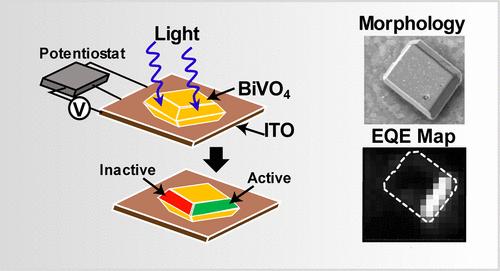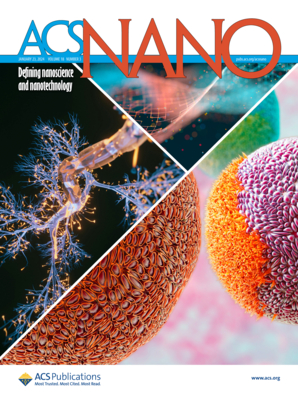Unequal {110} Facets: The Potential Role of Intraparticle Heterogeneity and Facet Termination in Photoelectrochemical Activity of Single BiVO4 Particles
IF 15.8
1区 材料科学
Q1 CHEMISTRY, MULTIDISCIPLINARY
引用次数: 0
Abstract
BiVO4 photoanodes are promising for solar water splitting, with photogenerated electrons and holes preferentially reacting at top {010} and lateral {110} facets, respectively. However, the mechanisms driving this facet-dependent reactivity remain unclear. Here, we investigate facet-dependent photocurrent and material heterogeneity using correlative scanning photoelectrochemical microscopy (SPCM), electron beam induced current (EBIC) mapping, and mid-IR scattering scanning near-field optical microscopy (s-SNOM). SPCM measurements of 62 BiVO4 particles confirmed higher photocurrents at lateral {110} facets compared to top {010} facets, but unexpectedly revealed variations in photocurrent among lateral facets within the same particle. Variations in lateral facet surface termination could explain the intraparticle-level reactivity heterogeneity, consistent with theoretical predictions. Nano-FTIR spectroscopy and Raman microspectroscopy indicated significant materials chemistry heterogeneity within individual particles and facets that could be attributed to variations in lattice vibration distortions that enhance the overlap between Bi 6s and O 2p orbitals. The increased orbital overlap is significant as it potentially increases hole mobility in the valence band and potentially explains the lateral facet-dependent charge separation efficiency observed in photocurrent maps. Facet-dependent electrical and EBIC measurements showed no space charge regions at interfacet junctions or metal-BiVO4 contacts under vacuum, suggesting that photogenerated holes beneath top {010} facets are unlikely to transport to lateral {110} facets to drive water/sulfite oxidation. These findings indicate the potential influence of distinct bulk properties and surface termination chemistries across different particles and facets, highlighting the importance of carefully controlling defects and surface chemistry during sample growth to optimize photocatalytic performance.

求助全文
约1分钟内获得全文
求助全文
来源期刊

ACS Nano
工程技术-材料科学:综合
CiteScore
26.00
自引率
4.10%
发文量
1627
审稿时长
1.7 months
期刊介绍:
ACS Nano, published monthly, serves as an international forum for comprehensive articles on nanoscience and nanotechnology research at the intersections of chemistry, biology, materials science, physics, and engineering. The journal fosters communication among scientists in these communities, facilitating collaboration, new research opportunities, and advancements through discoveries. ACS Nano covers synthesis, assembly, characterization, theory, and simulation of nanostructures, nanobiotechnology, nanofabrication, methods and tools for nanoscience and nanotechnology, and self- and directed-assembly. Alongside original research articles, it offers thorough reviews, perspectives on cutting-edge research, and discussions envisioning the future of nanoscience and nanotechnology.
 求助内容:
求助内容: 应助结果提醒方式:
应助结果提醒方式:


